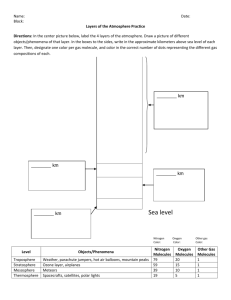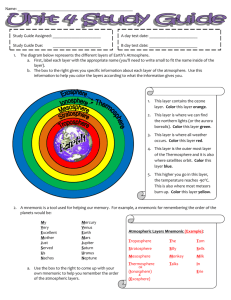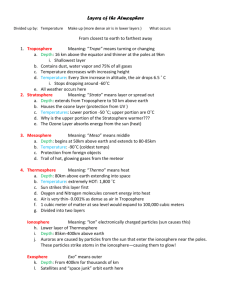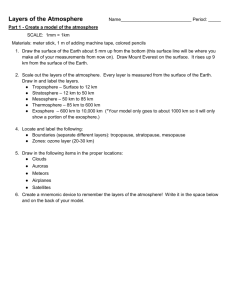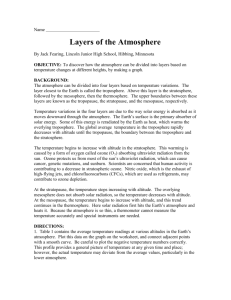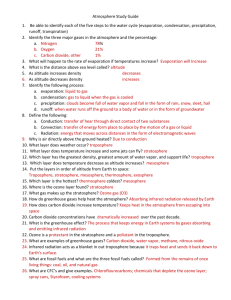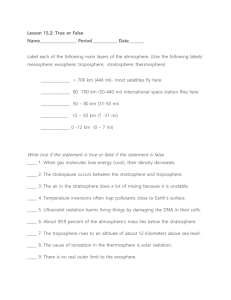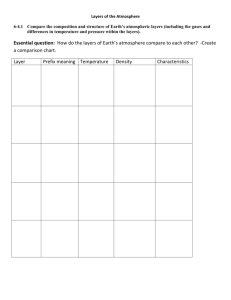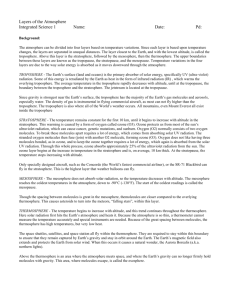Layers of the Atmosphere Activity
advertisement
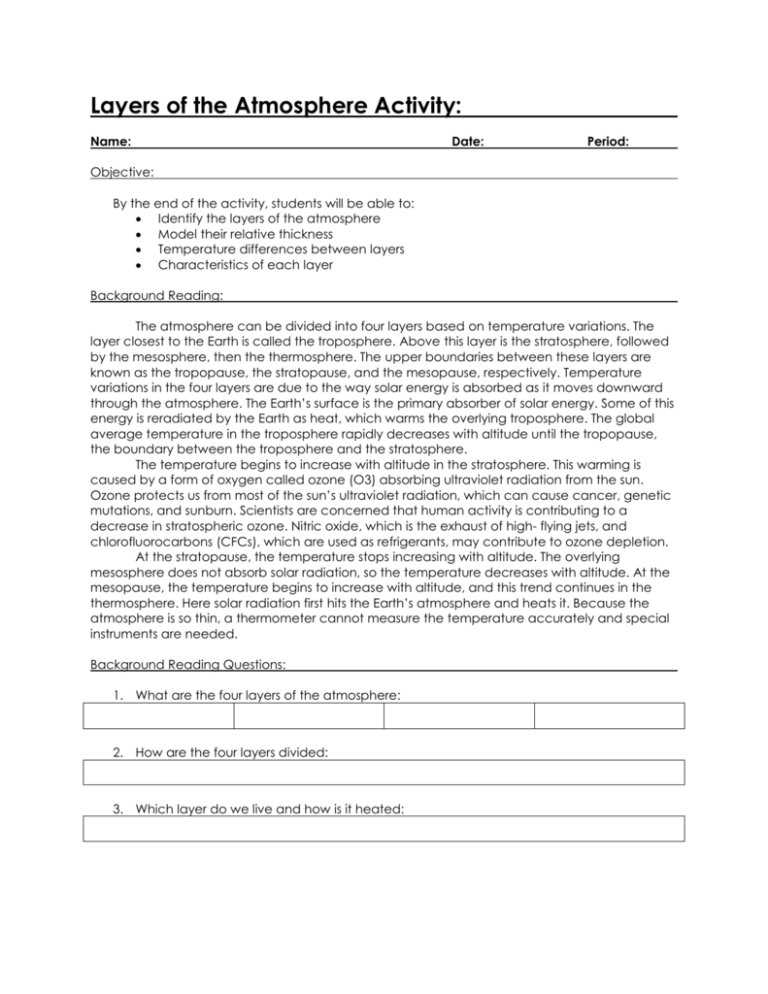
Layers of the Atmosphere Activity: Name: Date: Period: Objective: By the end of the activity, students will be able to: Identify the layers of the atmosphere Model their relative thickness Temperature differences between layers Characteristics of each layer Background Reading: The atmosphere can be divided into four layers based on temperature variations. The layer closest to the Earth is called the troposphere. Above this layer is the stratosphere, followed by the mesosphere, then the thermosphere. The upper boundaries between these layers are known as the tropopause, the stratopause, and the mesopause, respectively. Temperature variations in the four layers are due to the way solar energy is absorbed as it moves downward through the atmosphere. The Earth’s surface is the primary absorber of solar energy. Some of this energy is reradiated by the Earth as heat, which warms the overlying troposphere. The global average temperature in the troposphere rapidly decreases with altitude until the tropopause, the boundary between the troposphere and the stratosphere. The temperature begins to increase with altitude in the stratosphere. This warming is caused by a form of oxygen called ozone (O3) absorbing ultraviolet radiation from the sun. Ozone protects us from most of the sun’s ultraviolet radiation, which can cause cancer, genetic mutations, and sunburn. Scientists are concerned that human activity is contributing to a decrease in stratospheric ozone. Nitric oxide, which is the exhaust of high- flying jets, and chlorofluorocarbons (CFCs), which are used as refrigerants, may contribute to ozone depletion. At the stratopause, the temperature stops increasing with altitude. The overlying mesosphere does not absorb solar radiation, so the temperature decreases with altitude. At the mesopause, the temperature begins to increase with altitude, and this trend continues in the thermosphere. Here solar radiation first hits the Earth’s atmosphere and heats it. Because the atmosphere is so thin, a thermometer cannot measure the temperature accurately and special instruments are needed. Background Reading Questions: 1. What are the four layers of the atmosphere: 2. How are the four layers divided: 3. Which layer do we live and how is it heated: 4. What causes the stratosphere to be heated: 5. Outside of absorbing heat energy, what does the ozone layer do for us: Activity 1: 1. Table 1 contains the average temperature readings at various altitudes in the Earth’s atmosphere. Plot this data on the graph on the worksheet, and connect adjacent points with a smooth curve. Be careful to plot the negative temperature numbers correctly. This profile provides a general picture of temperature at any given time and place; however, the actual temperature may deviate from the average values, particularly in the lower atmosphere. 2. Label the different layers of the atmosphere. 3. Mark the general location of the ozone layer. You should place five words on your graph in the correct locations: troposphere, stratosphere, mesosphere, thermosphere and ozone layer. Activity 1 Analysis Questions: 1. Does the temperature increase or decrease with increasing altitude in the: Troposphere Stratosphere Mesosphere Thermosphere 2. What is the approximate height and temperature of the atmospheric layers: Approx. Height (km) Approx. Temperature (C) Atmospheric Layer Troposphere Stratosphere Mesosphere 3. What causes the temperature to increase with height in the stratosphere and decrease with height through the mesosphere? Activity 2: 1. Using the height you determined for each layer in activity one, you are now going to make a scale model using the scale of 1km = 1mm. Height in km above Atmospheric Layer Scale in mm Earth Troposphere Stratosphere Mesosphere Thermosphere 600 km 2. Using the ruler draw the following layers on the column on the next page. The bottom of the column represents sea level (0 km). 3. Using the ruler label the following on your diagram. a. Ship at Sea 0 km b. Manned Balloon 6 km c. Jet Plane 11 km d. Non Pressurized Plane 4 km e. Auroras 350 km f. Weather Balloon 40 km g. Stratus clouds 2 km h. Cirrus clouds 10 km i. Cumulus clouds 3 km j. Ozone layer 30 km Activity 2 Analysis Questions: 1. Based on the location of the clouds, in which layer does weather occur? 2. Air pressure is partially caused by the weight of all the air above it. Therefore, in Denver, since it is a higher elevation than Baltimore, they have less air pressure. Based on that knowledge, is the air more or less dense in Denver and why? 3. Based on question two, do you expect air pressure to increase or decrease as you increase in altitude:

